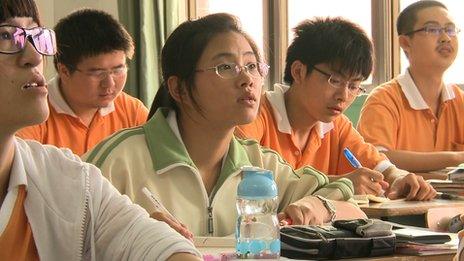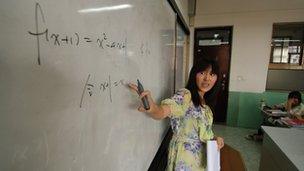China's students take on tough Gaokao university entrance exam
- Published

At least nine million students are expected to take the notoriously tough exam
Every year, police road blocks are set up around schools and nearby construction sites are ordered to fall silent as the country is plunged into two days of "Gaokao fever".
This year, 9.15 million Chinese high school students are sitting the notoriously tough university entrance exam.
Critics say that for most of them, it is the culmination of a year of cramming, of repeating past papers and in large part, learning by rote.
In fact, almost everyone - students, parents, teachers and policymakers - seems to accept that the system is squeezing creativity out of students.
But despite the criticism, China's exam machine just keeps on squeezing, and more horror stories emerge each year.
Most recently, photographs emerged of a classroom in Hubei province, showing students taking energy-boosting amino acids from intravenous drips hung from the ceiling.
Miserable experience?
But is the Gaokao experience always so taxing and miserable?
The BBC followed pupils at Zhabei Number 8 High School in Shanghai for a year. The school has a population of almost 500 students, spread over three grades.
In terms of the ability of its intake, it ranks near the bottom of the 10 state-funded schools in its district.
But the first thing that strikes a visitor is that this school shows no sign of the discipline problems that might be found in schools elsewhere in the world with large cohorts of relatively disadvantaged students.
It costs the taxpayer a little more than $2,000 (£1,291) per pupil per year. The buildings are modern and smart, the pupils are well turned out in their green tracksuits, and the classes are orderly.
And, like everywhere else in China, cramming and intense exam preparation are very much in evidence.
Long hours
Ma Li, 18, fits the profile of a beleaguered final-year student toiling on the exam treadmill.
Ma Li, 18, says that failure is not an option for her
Hard working and bright, she regularly puts in an extra six hours at home at the end of a 10-hour school day.
"This studying lifestyle is pretty hard," she says. "There's not much time to relax, but we're all in it together, and we encourage each other."
Ma Li, who hopes to study shipping logistics at Shanghai Maritime University, a top-tier college, is a good illustration of an aspect of China's education system that often goes unreported.
Her parents are migrant workers who moved to Shanghai in 1993 and she has profited from the city's now three-decades-old commitment to provide universal education.
In China, it is certainly true that like so many other places, students from wealthier backgrounds get into the better schools and therefore the better universities.
But the education system appears to be better than many at acting as an effective check on the opportunity gap growing too wide.
Shanghai's recent ranking as the world leader in maths, science and reading test scores in an Organisation for Economic Cooperation and Development (OECD) study underlines this point.
The data was not just based on the city's elite students, but on the scores of a cross-section of students from all abilities, including the children of migrant workers.
Not stereotypical
It's not hard though to find students who are less engaged.
Ding Zhenwei is in some ways a refreshing antidote to the stereotype of China's results-obsessed student masses.
He has set his sights relatively low and plans to study interior design at a second-tier private college.
So he is coasting, confident he would make the modest Gaokao mark he needs, and is doing barely any extra studying outside of school hours.
"Even if I do fail to get in, I'll find another way of making a success of my life," he says.
In fact, 80% of Zhabei's final year students make it into either a first or second-tier university every year.
That is impressive, given the school's intake of less advantaged pupils, but it is also a sign of China's higher education boom.
Ding Zhenwei explains why he is hoping to attend a second-tier private college
In the past decade, it has massively expanded university places to reach about 30 million, the highest number in the world by far.
While that change has done nothing to reduce competition for the most prestigious institutions, it may be leading at least some students to question the value of cramming for the Gaokao.
After all, what is the point of all that pressure and stress if it leads only to a place among the ranks of the country's unemployed?
More than one million fewer students will take the exam this year compared with the peak in 2008, and observers are wondering if that fall is due to some kind of "Gaokao fatigue".
But there are still those students who see the test as important enough to have a second go.
Wang Yu, 19, says she is determined to do better when she retakes the exam
Wang Yu, 19, is repeating her final year at Zhabei Number 8 High School because she did not get the Gaokao score she needed last time round.
"I already know the shame of failure," she says.
She is determined to do better this time so that she can rejoin her contemporaries who have started university without her.
Shining example
Education policy chiefs have long admitted the shortcomings of the Gaokao and have taken limited steps to try to introduce a more balanced and rounded education.

Zhabei Number 8 High School has close to 500 students
There is evidence in Zhabei, that students are now being trained to integrate knowledge and apply it to real-life problems.
The city's teachers are being extensively trained and there's lip service being paid to cutting those long study hours.
Shanghai was one of the first municipalities in China to stipulate a maximum amount of homework and set a minimum of one hour of physical activity a day.
How strictly those limits are being applied is another matter of course - at Zhabei, physical activity often seems to involve little more than a few minutes of choreographed group stretching exercises on the parade ground.
There is a consensus that China still leans far too much on preparation for exams and leaves too little time for real learning.
If future test takers from Zhabei Number 8 High School are really going to be given the chance to be tomorrow's creators, leaders and thinkers, then the system needs to change much faster.
If it does not, then some critics warn, that China may struggle to keep its economic boom on track.
- Published9 May 2012